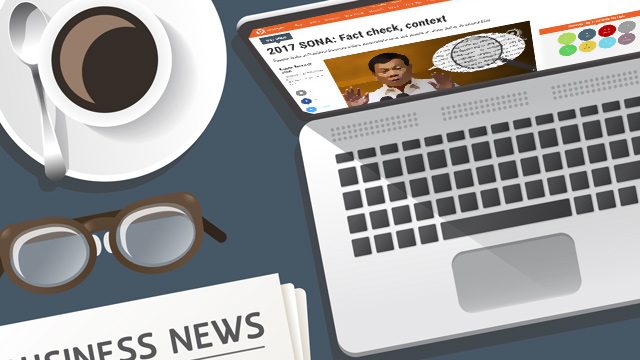SUMMARY
This is AI generated summarization, which may have errors. For context, always refer to the full article.

Rappler values truth-telling, facts, and factual reporting.
We correct at the first instance inaccuracies spotted in our own reports and point out false claims made by public officials and other influential accounts on social media. Fact-checking is done both internally and externally to create and sustain an environment anchored on truth.
Our fact-check efforts cover not just politics and governance issues but also others of public interest, particularly those that affect public safety. We fact-check:
- Statements by key public officials given their potential to translate to policy. This includes statements that contradict previous statements they made;
- Misleading statements or outright falsehoods by influential personalities which could affect public discourse or pose potential harm to the public;
- False claims and hoaxes circulated en masse on social media which could affect public safety, have the potential to influence public opinion, or incite hate.
The verification process follows the same that is done internally for fact-checking stories and other content.
To ensure that our reports and fact-checks are accurate, we employ internal accountability mechanisms as well as a multilevel process of verification built on the rich experience of our predecessor Newsbreak, an award-winning investigative news organization established in 2001.
1. The importance of accuracy, fairness, and balance is emphasized with the editorial team. When new team members are hired, they are oriented about these values spelled out in Rappler’s employee standards and Rappler’s editorial guidelines. Editors review and update these sets of documents as needed, given evolving newsroom experiences.
2. To aid in fact-checking and verification, Rappler’s research group independently gathers public-interest imbued data, documents, and other primary sources of information. These source materials, along with our archive of independently-verified content, are used to cross-check claims and information in stories, investigations, and fact-check pieces.
3. Whenever possible, we publish documents and data we used as sources for stories and fact-checks. We also actively hyperlink to other authoritative and credible first-hand sources, including websites of government agencies and the academe.
4. To the extent possible, we identify sources in stories we publish. Sources are informed that they are to be identified and quoted. There are three criteria for allowing anonymity of sources – track record of truthfulness, danger to life of a whistleblower or insider, and when the source’s information could be confirmed or verified by independent sources or documents. In such cases, we provide as much background as we can on unnamed sources without compromising their identity.
5. Editors serve as gatekeepers, seeing to it that reports are accurate, factual, and nuanced. When there are doubts about the accuracy of a story, the author’s attention is called and the necessary corrections are made. (READ: Corrections Policy) Key content, including fact-checks, special reports, and investigations are further reviewed by senior editors.
6. From time to time, we proactively publish fast facts and quick statistics to provide perspective and context to current events. These are mostly published under Rappler IQ, a subsection of Newsbreak, now Rappler’s investigative and research arm. External fact-checks are published under the Fact Check section.
7. During major events such as the President’s annual State of the Nation Address, election debates, etc., researchers, reporters, and editors work together to fact-check and contextualize statements made by officials and candidates real-time.
8. Alerts about fake content or fake news are sent out via social media posts, infographics, video, and stories that elaborate on the flagged false information. Fake content actively flagged include photos, text, links to stories, opinion pieces, video, infographics, and other shareable information.
On a day-to-day basis, we adopt the following workflow in external fact-checking:
1. Spotting claims to fact-check. We actively encourage our community to submit dubious content for fact-checking through regular crowdsourcing call-outs. On top of events covered by our own field reporters and contributors, we monitor the following information channels for claims that are either misleading or untrue:
- other news organizations
- public posts by influential websites, accounts, groups, and pages on social media
- submissions from the public either posted through our comments section, sent by email, or sent via Facebook messenger
2. How we prioritize. We use the following guide questions to select what content to fact-check:
- Are there verifiable details in the content?
- Is the context of the claim relevant to the public? Is the claim related to current news reports?
- Does the claim have the potential to damage the subject’s reputation? Related to this, does it bother the subject matter?
- Does it have the potential to go viral? Are real people sharing this claim?
3. How we rate claims. A team of researchers does the initial verification process. They check for verifiable details including names, places, dates, numbers, and others. Reporters get looped into the verification process whenever content topics involve their respective beats or areas of expertise. After the facts have been established, the appropriate rating is discussed internally with editors on duty. Within fact-check pieces, we provide readers with as much information as possible to explain how we arrived at a particular conclusion or rating. For content from hoax sites, we also provide additional information on previous content published by such sites which have previously been established as false.
To suggest stories for fact-checking and give us feedback on previous fact-checks, email us through factcheck@rappler.com. You can send us links to dubious content on Facebook by forwarding them to facebook.com/newsbreak.ph using Facebook Messenger. – Rappler.com
Add a comment
How does this make you feel?
There are no comments yet. Add your comment to start the conversation.